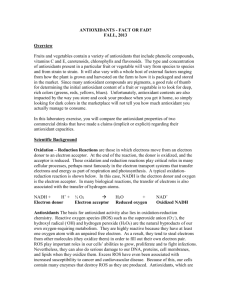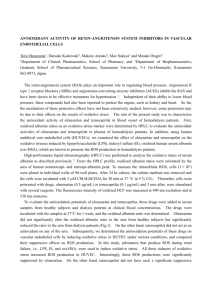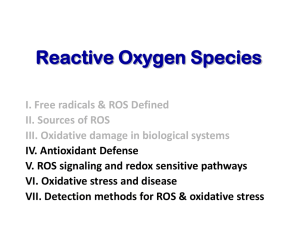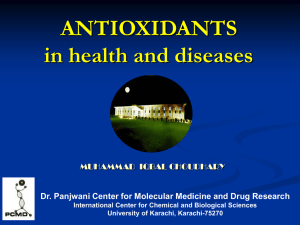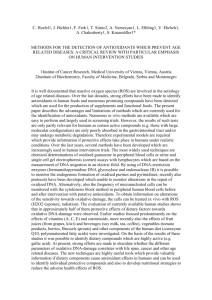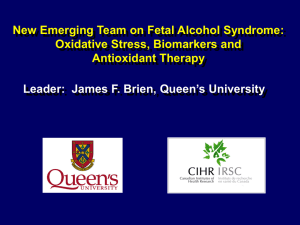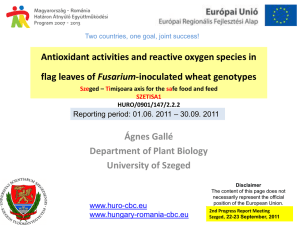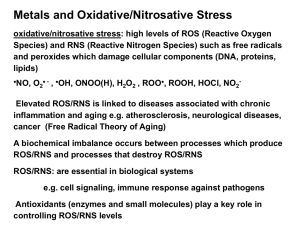Targeting Oxidative Stress in Neurodegeneration
advertisement
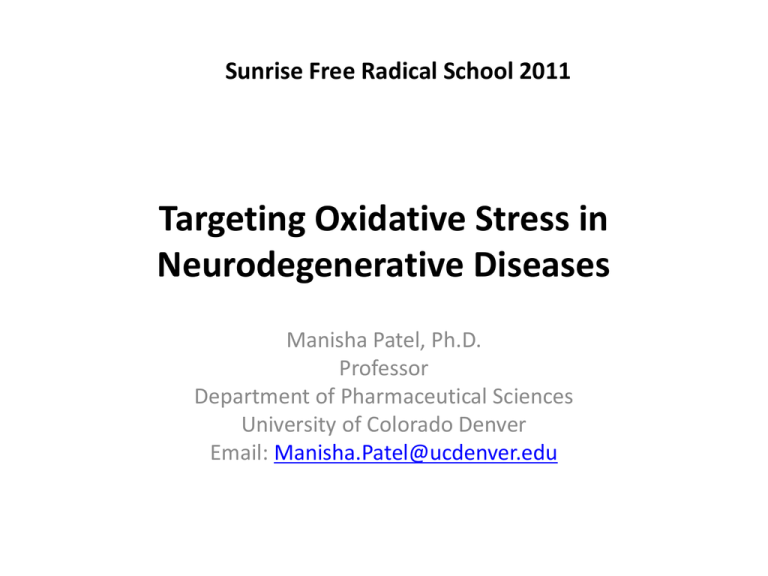
Sunrise Free Radical School 2011 Targeting Oxidative Stress in Neurodegenerative Diseases Manisha Patel, Ph.D. Professor Department of Pharmaceutical Sciences University of Colorado Denver Email: Manisha.Patel@ucdenver.edu Outline • Neurodegeneration: unique vulnerability and considerations for intervention • Targeting oxidative stress in neuronal disorders – Classification – Issues related to drug development – Three examples of antioxidants – Questions arising from failures – Non-pharmacological approaches – Challenges Definitions Oxidative stress (Kemp et al. 2008) “An imbalance in prooxidants and antioxidants with associated disruption of redox circuitry and macromolecular damage” Antioxidant (Halliwell and Gutteridge, 2007) “ A substance that, when present at a low concentration compared with that of an oxidizable substrate, inhibits oxidation of the substrate” The Brain is Uniquely Vulnerable to Oxidative Damage • Intolerance for blood flow interruptions • Limited regeneration-although neurogenesis and gliogenesis can be stimulated • Circuit-based functions-small deficits have huge impact • Aging sensitive • Ca-dependent processes • PUFAs The Brain is Uniquely Vulnerable to Oxidative Damage • Multiple sources of ROS generation (e.g. MAO, Aconitase, aKGDH, Nox(s), Complex I, P450s, neurotrophic factor withdrawal • Redox active metal-rich (catalytic iron) • Autooxidation of monoamines • Glutamate excitotoxicity • Limited antioxidant and repair capacity (low catalase, mitochondria lack catalase) • Resident immune cells (microglia) produce ROS and cytokines Multiple Cell Types in the Brain with Unique Structures and Functions From: Kapogiannis and Mattson, 2011 Additional Considerations for Targeting the Brain • Blood brain barrier • Energetics • Protein aggregation • Cognitive (dys)function Common Mediators of Neurodegeneraton • Reactive species and oxidative/nitrative damage-which offending species? • Mitochondrial dysfunction • Proteosomal dysfunction • Abnormal protein aggregates • Inflammation Criteria for consideration of antioxidant therapy • What specific reactive species (RS) is responsible? Does disease have a strong rationale for reactive species involvement? • What is the target? • Specific species or broad spectrum? • Specific cellular compartment or diffuse action? • Is the ROS or oxidative damage demonstrated at injury site? • Is the formation of ROS precede or accompany the injury process? • Does modulation of the ROS impact disease processes or pathology? • What are your biomarkers of efficacy? Classification of Antioxidants • Direct Antioxidants – Free radical scavengers (SOD/O2-.) – Non radical scavengers (Catalase/H2O2) • Indirect Antioxidants – Inhibitors of cellular sources of oxidants (chelators/metals, apocynin/Nox) – Inducers of cellular antioxidants (sulforaphane/Nrf2 targets-GSH) Natural Antioxidant and Mimics • Many of these compounds share aromatic rings substituted with hydroxyl groups. • They can directly scavenge peroxyl and hydroxyl radicals, peroxynitrite, and hypochlorous acid. • Major antioxidant mechanisms include the ability to delocalize charge, semi-quinone formation. • Can also produce pro-oxidant effects and may induced endogenous antioxidants through nrf2 activation. • Vitamin E and/or C, thiols, CoQ, polyphenols Antioxidant Enzyme Mimics • Two major classes based on endogenous enzymes that scavenge superoxide and hydrogen peroxide. – SOD mimics that are selective and non-selective and some that contain a redox active metal. • Require either fast rate of reaction with superoxide or can accumulate in cells and tissues to high levels. – Peroxidase mimics that are selenium based or contain a redox active metal. • Selenium-based compounds need to be stable and usually require endogenous antioxidants like GSH to recycle compounds to active state. • Metal-based compounds need to have good affinity for metal and can form high oxygen states that can be pro-oxidant under low endogenous antioxidant conditions. Non-Metal Catalytic Antioxidants • Two major classes are the spin traps and the fullerenes and both can scavenge superoxide. – Spin traps best characterized are the nitroxides and include TEMPOL and PBN. – Fullerenes are large C60 nanoparticles. • Both groups likely require endogenous regeneration to act catalytic. • Nitroxides are chain breaking antioxidants. Desirable Properties of Compounds Neurodegenerative Diseases Antioxidants • • • • • • • • Efficacy (high rate constant with ROS) Stability Safety Favorable pharmacokinetic properties Specificity for RS Cell and mitochondria permeable Non-antigenic Non-toxic metabolites • • • • • • Efficacy, potency Stability Safety Favorable pharmacokinetic properties Blood-brain-barrier permeability Oral bioavailability Issues Related to Synthetic Antioxidant Development (Direct Scavengers) • Which ROS/RNS target(s) to screen against? • Which biochemical assays predict biological activity? • Are the factors that make an ideal antioxidant compatible with factors required for drug development? • Symptomatic relief vs disease modification (i.e. motor function vs underlying pathology) • Co-morbidities (e.g. cognitive dysfunction) NXY-059 (CeroviveR) in stroke • Nitroxide spin trap • Stable free radicals that react with O2-. • Closely adhered to preclinical STAIR guidelines: •Animal models of both permanent and temporary focal ischemia •Testing in more than one laboratory •Demonstrating efficacy in more than one animal species, including nonhuman primates •Testing in both male and female animals •Measurement of both behavioral and histological outcomes •Showing efficacy with drug administration at 1 hour after ischemia or beyond • Marginally positive clinical trial (SAINT I) The SAINT II Trial, a large randomized multicenter clinical trial of the NXY059, failed to demonstrate a treatment benefit in acute ischemic stroke halting further clinical development Why did NXY-059 fail? Lessons and future of neuroprotective drugs • Physiochemical shortcomings of NXY-059 – polar, nonlipophilic nature, poor blood–brain barrier penetrability, nonphysiological oxidation potential, and low potency (Ginsburg, Stroke 2007) • Lack of biomarker assessing oxidative stress – Accessibility of target tissue is problematic in brain disorders • Heterogeneity in individual human responses and responses to drug treatment – Problem with most clinical studies • Need more optimization of preclinical studies (despite close adherence to STAIR guidelines) • Stroke is a formidable disorder –only one approved therapy to date Mitochondria-specific targeting with MitoQ • • • • • • • • Smith and Murphy, AAS 2010 Efficacious in preclinical studies Stable Well tolerated Favorable pharmacokinetic properties Specificity for ROS –not highly specific Blood-brain-barrier permeable Cell and mitochondria permeable Oral bioavailable Lack of efficacy in clinical trial of Parkinson’s disease (PROTECT study) MCT of 13 centers, placebo vs 2 doses of MitoQ (Snow et al., 2010) Potential reasons for negative result: •Lack of efficacy may be related to timing of drug administration (too late) •Lack of correlation with appropriate biomarker(s) of oxidative damage Drugs in clinical development for Parkinson’s disease Include several indirect and direct modulators of oxidative stress Meissner et al. 2011 Ongoing Trials for Parkinson’s disease: Disease modification or neuroprotection Coenzyme Q10 Modulator of mitochondrial function III Change in UPDRS total score Creatine Modulator of mitochondrial function III Disease progression over 5 years Deferiprone Iron chelator II/III Decrease in substantia nigra iron overload (UPDRS I–IV) Inosine Urate precursor II Tolerability and safety Isradipine CR Calcium antagonist II Tolerability (UPDRS II and III) II Tolerability (UPDRS) G-CSF Haematopoietic growth factor II UPDRS III Green tea polyphenols Antioxidant II Delay of progression of motor dysfunction AAV2-Neurturin (CERE120) Neurotrophic growth factor; intraputaminal and intranigral injection I/II Change from baseline in UPDRS III in OFF condition PDGF (sNN0031) Intracerebroventricular injection of PDGF I/II Safety and tolerability (UPDRS) Cogane (PYM-50028) Oral neurotrophic factor modulator II Change from baseline in UPRDS II and III Modified from: Meissner et al., Nature Reviews 2011 Targeting cognitive dysfunction Formation of E2- and D2-Isoketals D2-Isoketals Via the IsoP Pathway R O O R' H2-IsoP Reduction OH Rearrangement O R O R R NH2 + R' OH F2-IsoP R' O E2-IsoK Courtesy: J. Roberts, Vanderbilt U. • IsoKs are formed in the lipid bilayer • Salicylamine, an effective lipophilic scavenger and a natural product from buckwheat seeds, is ~980 times more reactive than lysine with IsoKs R' OH O D2-IsoK 2-Hydroxy-benzylamine (salicyalmine) Scavenging E2- and D2-Isoketals with salicylamine in human and experimental Alzheimer’s disease IHC of Human AD Brain for IsoK Protein Adducts Brown Indicates Positive Staining Aged-Matched Control AD Hippocampus Hippocampus Neuropil Neuron Neuron 1-way ANOVA p = 0.0026 p < 0.01 p < 0.01 Effect of Salicylamine Treatment on Prevention of Working Memory Deficits in hApoE4 Transgenic Mice Water Radial Arm Maze % WT Time to Platform 160 140 120 100 80 60 Courtesy: J. Roberts, Vanderbilt U. WT hApoE4 (No SA) hApoE4 (SA) Oxidative Stress Response e.g. Neurotrophic factors, Neurogenesis, DNA repair etc Adaptation Responses Failure to adapt ROS/RNS Apoptosis Necrosis Oxidation of proteins, lipids and DNA Organelle dysfunction Calcium dysregulation The Ketogenic Diet (KD) • Mimics fasting state – switches from metabolism of glucose to metabolism of ketones • Clinically-used treatment for intractable seizures in children and adolescents • High fat – low carbohydrate (4:1, fat:non-fat) • Efficacy appears to be independent of seizure type • Mechanism of action unknown but attributed to ketone bodies , glycolysis and mitochondrial metabolism • Research direction: clinic to bench Mitochondrial effects of the ketogenic diet – Increased mitochondrial biogenesis in KD (Bough et al, Ann Neurol, 60:223-235, 2006) – Upregulation of uncoupling proteins (UCPs) (Sullivan et al, Ann Neurol, 55:576-580, 2004) – Increased mitochondrial glutathione and increased γ-GCL activity (Jarrett et al., J. Neurochem 2009) Activation of the Nrf-2 Adaptive response in the ketogenic diet Biphasic Hippocampal H2O2 production Mitochondria 150 H2O2 production (% control) * 100 Ketogenic Diet ** 1-3 days Mild oxidative/electrophilic stress (H2O2, 4-HNE) 50 Protein kinase cascade 0 Control 1 day (A) 3 days 1 week 3 weeks Keap1 Time on Diet Nuclear Nrf-2 accumulation Nrf2 Keap1 Nucleus Nrf2 Actin ~ 1 week 3d Band density (% control) (B) 1wk Control 3wk 3d 1wk KD 3wk Nrf2 140 ** 120 ** ARE Target gene transcription (Gclc, Gclm, Nqo1, Ho-1) 100 Antioxidant Response 80 60 >3 weeks ROS 3 days 1 week 3 weeks Time on Diet Milder et al., Neurobiol. Dis. 2010 Milder and Patel, Epilepsy Res. 2011 Metabolic Regulation of Cognitive Dysfunction: Non-Pharmacological Approaches Indirectly Targeting Reactive Species • Diabetes aggravates and energetic challenges attenuate CNS inflammation • Exercise and caloric restriction ameliorate and diabetes exacerbates Alzheimer’s disease models • Cognitive impairment associated with trauma or ischemia can be modified by caloric intake and exercise Regulation of Cognitive Function by metabolic factors, oxidative stress and inflammation Exercise Caloric Restriction PGC-1a Mild Oxidative Stress Sedentary Lifestyle Diabetes, Obesity High cholesterol Adaptive Cellular Stress Responses Neurogenesis Neuroprotection Synaptic Plasiticity BDNF IGFs HSPs UCPs MnSOD HO-1 Cognitive Impairment Disease Progression Oxidative Stress Inflammation Impaired Synaptic Plasticity Impaired Neurognesis Neurodegeneration Cognitive Impairment Disease Progression Adapted from: Stranahan and Mattson, 2011 Is oxidative stress a “druggable” target for brain disorders? • Should ROS be a target for brain disorders? (Floyd et al., FRBM 2011) – Low levels of drug vs diffuse and high levels of ROS – Drugs targeting sources of ROS may work better • Dual roles of ROS: Signaling vs damage – Do antioxidant compounds interfere with physiological processes? Does redox signaling role interfere with antioxidant efficacy? – Maybe, but goal of antioxidant therapy in disease states is to normalize elevated ROS levels and oxidative damage • Are ROS merely associated with the disease process or play a causative role? – Criteria for assigning a causative role of ROS must be considered (Halliwell and Gutteridge, 2007) Need biomarker-guided clinical studies to verify antioxidant efficacy • Lack of verification of oxidative damage using appropriate biomarkers may explain failure of antioxidant clinical trials • Biomarkers for monitoring antioxidant efficacy – Need to consider both free radical and non-radical species (e.g. F2-ISOP, 8-OH-dG, GSH/GSSG, CyS/CySS) – Need organ specific biomarkers • CSF is difficult to sample Challenges • Develop therapies that take into account both the beneficial and the harmful effects of ROS • Biomarkers –CNS is a target organ difficult to access • Predictable preclinical studies • Timing of treatment • Heterogeneity of diseases • Individual variability and variability of drug responses • Better drugs and interventional design • Better targets e.g. sources of ROS, specific species of ROS References • • • • • • • • • • Halliwell B and Gutteridge J. Reactive species and disease: Fact, fiction or filbuster. In “Free Radicals in Biology and Medicine” 4th Edition, Oxford Biosciences, 2007. M. Kemp, Go and D.P. Jones, Nonequilibrium thermodynamics of thiol/disulfide redox systems: a perspective on redox systems biology. Free Radic. Biol. Med., 44 (2008), pp. 921–937. Floyd RA, Towner RA, He T, Hensley K, Maples KR. Translational research involving oxidative stress and disease of aging. Free Radic Biol Med. 2011 Sep 1;51(5):931-41. Stranahan AM, Mattson MP. Bidirectional metabolic regulation of neurocognitive function. Neurobiol Learn Mem. 2011 Jan 12. Kapogiannis D, Mattson MP. Disrupted energy metabolism and neuronal circuit dysfunction in cognitive impairment and Alzheimer's disease. Lancet Neurol. 2011 Feb;10(2):187-98. Meissner WG, Frasier M, Gasser T, Goetz CG, Lozano A, Piccini P, Obeso JA, Rascol O, Schapira A, Voon V, Weiner DM, Tison F, Bezard E. Priorities in Parkinson's disease research. Nat Rev Drug Discov. 2011 May;10(5):377-93. Milder JB, Patel M. Modulation of oxidative stress and mitochondrial function by the ketogenic diet. Epilepsy Res. In press. Milder JB, Liang LP, Patel M. Acute oxidative stress and systemic Nrf2 activation by the ketogenic diet. Neurobiol Dis. 2010 Oct;40(1):238-44. Smith RA, Murphy MP Animal and human studies with the mitochondria-targeted antioxidant MitoQ. Ann N Y Acad Sci. 2010 Jul;1201:96-103. Davies, S.S, Bodinea, C, Matafonovaa, E, Pantazidesa, B.G., Bernoud-Hubacc, N, Harrisond, F.E., Olsone, S.J., Montine T.J., Amarnathe V. , Roberts L.J. 2nd . Treatment with a γ-Ketoaldehyde Scavenger Prevents Working Memory Deficits in hApoE4 Mice. JAD in press.

